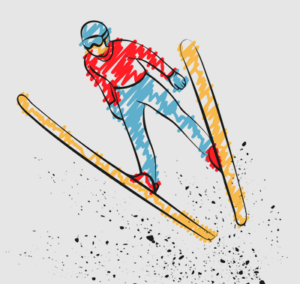 The simply reality about most sports is that anyone who has played them at any level can have that feeling at the back of their brain that they’ve have been able to do it professionally if only a couple of small things had gone differently. Perhaps those that play football feel that they just needed to be fitter, or golfers think they just needed to have been introduced to the sport at an earlier age. The same sort of things could perhaps be said about alpine skiing, but few would even attempt to do a ski jump, let alone believe that they’d have been able to do it at the highest level regardless of what breaks had gone their way.
The simply reality about most sports is that anyone who has played them at any level can have that feeling at the back of their brain that they’ve have been able to do it professionally if only a couple of small things had gone differently. Perhaps those that play football feel that they just needed to be fitter, or golfers think they just needed to have been introduced to the sport at an earlier age. The same sort of things could perhaps be said about alpine skiing, but few would even attempt to do a ski jump, let alone believe that they’d have been able to do it at the highest level regardless of what breaks had gone their way.
Ski jumping requires competitors to head down a specially built ramp or slope and then jump as far as possible at the end of it. Jumps are also evaluated according to a number of things in addition to simply distance, with the style of the jumper’s performance also a key factor. As a result, jumping styles have evolved and varied over the years according to what was popular at the time. One of the most thrilling events at the Winter Olympics since its introduction in 1924, the sport can seem to be as impenetrable as pool diving the the uninitiated because of the fact that the ultimate decision is left to judges who typically score jumpers out of 20 for their style.
Top Betting Site For Ski Jumping
Bet365

There is no bigger or better bookmaker for skiing, and winter sports in general, than Bet365. They reliably cover all Ski Jumping major events from the World Cup to Wisla, Raw Air, 4 Hills and the Ski Fying world cup and championships.
Outright prices are available a long time in advance and for upcoming events you can find greater depth of market, including match-ups, winning and points margins, podium finishes and other specials. Prices are usually exceptional too in our experience.
Another good option closer to events are the other bigger brands who also have a good market depth and plenty of all sports offers that can be used for betting on skiing
How To Bet On Ski Jumping
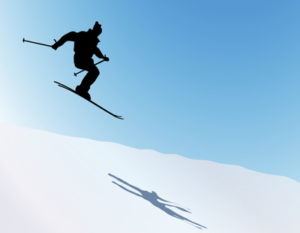 If you’ve read any of our other guides on skiing events then you’ll know that the majority of bookmakers don’t tend to offer particularly in-depth odds on skiing disciplines. Instead, you’ll need to try to find some specialist bookies if you’re hoping to place more than just a passing bet on anything other than the most mainstream of markets.
If you’ve read any of our other guides on skiing events then you’ll know that the majority of bookmakers don’t tend to offer particularly in-depth odds on skiing disciplines. Instead, you’ll need to try to find some specialist bookies if you’re hoping to place more than just a passing bet on anything other than the most mainstream of markets.
That being said, most bookmakers will offer you odds on the outright markets on the biggest events during a season, especially when it comes to the Winter Olympics. Betting ante-post will usually give you the best odds, but even then you’ll likely find that there’s a clear favourite that you’ll struggle to get anything other than tight odds for.
You can often bet on the Versus market, whereby you look to see if one jumper will finish higher on the table than another regardless of who ultimately wins. You’ll also be able to bet on the likes of the nationality of the winning jumper, should you not want to nail your colours to the mast on a specific competitor. Mainly, though, it will be the outright market that you’ll discover is easiest to find on the big, non-specialist sites.
The History Of Ski Jumping

Ski jumping joins alpine and cross-country skiing as being part of the nordic tradition of skiing discipline, with the first ski jumping competitions being held in Norway during the 19th century.
There is some evidence that it might even have been taking part before then, with some suggestions that it could have been happening towards the end of the 18th century. Indeed, the first recorded ski jump took place in 1808 when Olaf Rye managed to jump as far as 31 foot.
The Early Days Of Ski Jump Competitions
![]() As with practically every sport that has ever been invented, it didn’t take long for those that enjoyed ski jumping to develop it into a competitive sport. The first known competition in the discipline took place in the Norwegian principality of Høydalsmo in 1866 and was won by the man generally considered to be the father of modern ski jumping, Sondre Norheim.
As with practically every sport that has ever been invented, it didn’t take long for those that enjoyed ski jumping to develop it into a competitive sport. The first known competition in the discipline took place in the Norwegian principality of Høydalsmo in 1866 and was won by the man generally considered to be the father of modern ski jumping, Sondre Norheim.
A larger ski jumping tournament was held nine years later on Oslo’s Husebyrennet hill, being successful enough to mean that it was held again there for a number of years before the poor infrastructure meant that it needed to be moved to Holmenkollen in 1892, where it has remained ever since. The event at Holmenkollen remains one of the main ski jump meetings of the season.
Ski Jumping Starts To Spread
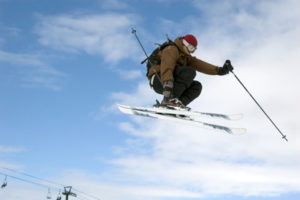 Towards the end of the 19th century Sondre Norheim and the Norwegian Nordic skier Karl Hovelsen decided to immigrate to the United States of America, taking ski jumping with them. At a similar sort of time, the Norwegian Nels Nelsen immigrated to Canada and introduced the sport to America’s neighbours. He hosted a ski jumping competition on Mount Revelstoke in 1915, designing the ski hill there and then hosting the tournament every year.
Towards the end of the 19th century Sondre Norheim and the Norwegian Nordic skier Karl Hovelsen decided to immigrate to the United States of America, taking ski jumping with them. At a similar sort of time, the Norwegian Nels Nelsen immigrated to Canada and introduced the sport to America’s neighbours. He hosted a ski jumping competition on Mount Revelstoke in 1915, designing the ski hill there and then hosting the tournament every year.
The ski jumping competition at Mount Revelstoke continued until the 1960s, with many considering it to be the best ski jump in the world. It was the biggest natural ski jump in Canada and both its natural grade and its length allowed jumpers to reach distances of more than 200 foot, which was the longest in the country. Ski jumping records were repeatedly set and then broken over the decades that followed the introduction of the jump, including in 1916, 1925 and 1933.
Ski Jumping Becomes An Olympic Event
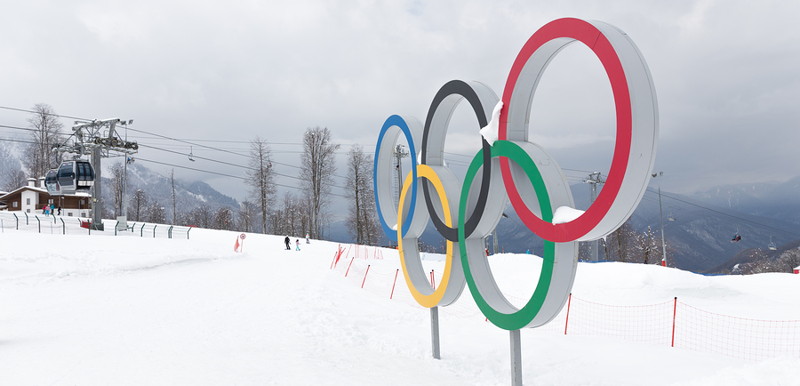
Its growing popularity and the fact that it had started to be spread around the globe naturally meant that ski jumping soon began to attract the attention of the International Olympics Committee, which was looking for sports to be added to the roster for its upcoming inaugural meeting in the winter of 1924. They already had bobsleigh, ice hockey, skating and curling, but they felt that more needed to be added in order to give the event the heft that it deserved.
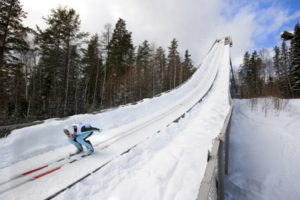 That heft was provided by the addition of Nordic skiing, which itself was broken down into four constituent parts. Military patrol asked skiers to ski and then shoot targets, whilst cross-country skiing required competitors to take on the daunting long distance ski slopes. Nordic combined added together cross-country skiing and ski jumping, with the latter being one of the most exciting parts of the new competition taking place in Chamonix, France. It has been on the Winter Olympic roster ever since.
That heft was provided by the addition of Nordic skiing, which itself was broken down into four constituent parts. Military patrol asked skiers to ski and then shoot targets, whilst cross-country skiing required competitors to take on the daunting long distance ski slopes. Nordic combined added together cross-country skiing and ski jumping, with the latter being one of the most exciting parts of the new competition taking place in Chamonix, France. It has been on the Winter Olympic roster ever since.
The Sport Is Developed
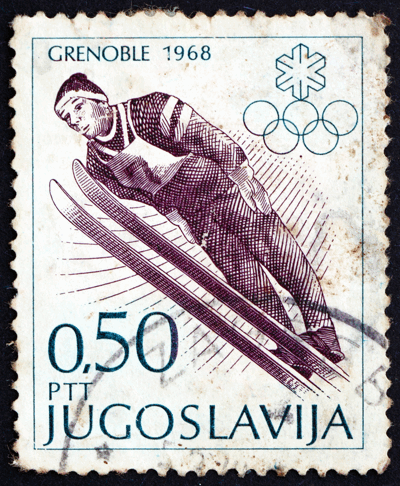 Whilst people were breaking records with a fair degree of regularity at Mount Revelstoke during the 1920s and 1930s, it was in in 1935 Slovenia that a new twist on the sport took place for the first time to leave people wondering how far things could go. Josef Bradl introduced something that would become known as ski flying when jumped over 330 foot at the alpine ski valley of Planica. Interesting, the first jump of more than 660 foot was achieved at the same location nearly 60 years later when Toni Nieminen achieved it in 1994.
Whilst people were breaking records with a fair degree of regularity at Mount Revelstoke during the 1920s and 1930s, it was in in 1935 Slovenia that a new twist on the sport took place for the first time to leave people wondering how far things could go. Josef Bradl introduced something that would become known as ski flying when jumped over 330 foot at the alpine ski valley of Planica. Interesting, the first jump of more than 660 foot was achieved at the same location nearly 60 years later when Toni Nieminen achieved it in 1994.
The FIS Nordic World Ski Championships had started in 1925 for men, with women being allowed to compete in it from 1954 onwards. It was hosted by the town of Zakopane in Poland in 1964 and as part of the meeting the large hill event was introduced for the first time. In the same year the Winter Olympics included the normal hill event for the first time. It wasn’t until 1988 that the team ski jumping event was added to the Olympic roster when the meeting was held at the Canadian resort of Calgary.
Eddie ‘The Eagle’
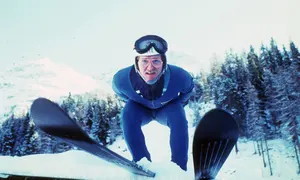 Whilst the 1988 edition of the Winter Olympics at Calgary will always be remembered seriously because it was the first time that the team ski jumping event had taken place, it will also go down in history for two other reasons. The first has nothing to do with ski jumping but is arguably one of the most memorable moments in Winter Olympics history thanks to the film Cool Runnings – the introduction of the Jamaica national bobsled team.
Whilst the 1988 edition of the Winter Olympics at Calgary will always be remembered seriously because it was the first time that the team ski jumping event had taken place, it will also go down in history for two other reasons. The first has nothing to do with ski jumping but is arguably one of the most memorable moments in Winter Olympics history thanks to the film Cool Runnings – the introduction of the Jamaica national bobsled team.
The other was the introduction to the world of Michael Edwards, better known as Eddie ‘The Eagle’ Edwards. He began life as a downhill skier but couldn’t make the grade, deciding to make the switch to ski jumping because there were no others doing so for Britain meaning that he didn’t need to compete for a place. It’s fair to say that Eddie was never likely to be taken seriously as a competitive ski jumper, being around 20 pounds heavier than the next closest competitor and needing to wear thick glasses for his far-sightedness that would steam up at altitude.
![]() Nevertheless, he competed for Great Britain at the 1987 World Championships and earned a ranking of 55th in the world, qualifying him to take part in the 1988 Winter Olympics on behalf of Great Britain. Despite holding the British record for a ski jumper until 1994, Edwards finished last in both the 70 metre and 90 metre events. His amusing story as well as his complete lack of success on the world stage made him an endearing figure to those outside of the ski jumping community, but inside he was seen as an embarrassment to such an extent that in 1990 the IOC instituted rule that became known as the ‘Eddie The Eagle Rule’, stopping unlikely competitors from being able to qualify for Winter Olympic events.
Nevertheless, he competed for Great Britain at the 1987 World Championships and earned a ranking of 55th in the world, qualifying him to take part in the 1988 Winter Olympics on behalf of Great Britain. Despite holding the British record for a ski jumper until 1994, Edwards finished last in both the 70 metre and 90 metre events. His amusing story as well as his complete lack of success on the world stage made him an endearing figure to those outside of the ski jumping community, but inside he was seen as an embarrassment to such an extent that in 1990 the IOC instituted rule that became known as the ‘Eddie The Eagle Rule’, stopping unlikely competitors from being able to qualify for Winter Olympic events.
Rules and How Ski Jumping Works

Ski jumpers take on the ski jumping hill, which consists of a steep hill that boasts a jumping ramp, the take-off point and a hill to land on. The competitors all start at the same point and ski down the in-run at such a speed that their take-off from the take-off table is sufficient to see them airborne as long as they jump sufficiently well.
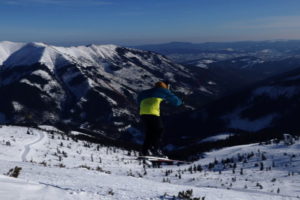 When the skier gets airborne they need to maintain an aerodynamic posture in order to allow them to travel as far as possible. They then move in such a way that their position in the air gets gradually closer to the ground in order to ensure a gentle and safe landing on the landing space. Once they’ve landed they can then ski into the ‘out-run’ that lets them slow down naturally.
When the skier gets airborne they need to maintain an aerodynamic posture in order to allow them to travel as far as possible. They then move in such a way that their position in the air gets gradually closer to the ground in order to ensure a gentle and safe landing on the landing space. Once they’ve landed they can then ski into the ‘out-run’ that lets them slow down naturally.
The classification of the slopes is based on the distance that competitors can travel when in the air, with the following being the information necessary to understand the ski jump type:
| Hill Class | Hill Size | Construction Point |
|---|---|---|
| Small | Up to 50 metres | Up to 45 Metres |
| Medium | Between 50 & 84 Metres | From 45 Metres to 74 Metres |
| Normal | Between 85 & 109 Metres | From 75 Metres to 99 Metres |
| Large | Between 110 & 184 Metres | From 100 Metres to 169 Metres |
| Ski Flying | More than 185 Metres | More than 170 Metres |
The construction point, also know as the K-Point, is the target point that the competitors should be trying to reach.
How Ski Jumping Is Scored
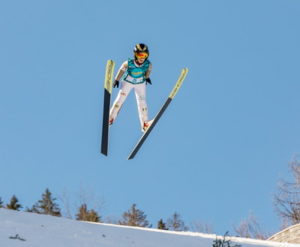 As mentioned elsewhere, ski jumping isn’t just about the distance that the competitors can reach once they’ve taken off from the take-off table. Instead, they are scored according to how they’ve performed in the following areas:
As mentioned elsewhere, ski jumping isn’t just about the distance that the competitors can reach once they’ve taken off from the take-off table. Instead, they are scored according to how they’ve performed in the following areas:
- Distance
- In-Run Length
- Wind Conditions
- Style
In individual events the skiers have two competitive jumps that are combined in order to create an overall score. The point of the various components of a jump is to stop one skier jumping in the morning travelling further than one in the afternoon because of the weather, theoretically making things fairer for all competitors.
The distance is dependent on the K-Point of the hill that is being competed on, with 60 points being available for normal and large hills and 120 points on flying hills, provided they hit their K-Point target. If they go further than the K-Point then they get more points accordingly.
Up to 20 points per judge can be awarded for the jumping style, with 5 judges usually presiding over competitions. Competitors need to keep their skis steady, maintain their balance, land well and keep their body in the optimum position throughout the jump. The highest score and the lowest score get removed and the remaining three scores are then added together along with the distance score.
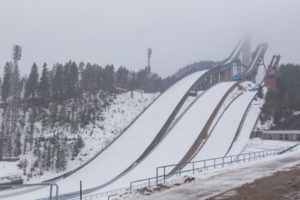 If the starting position is altered then points are either added or subtracted depending on whether the new gate position will give skiers a better or worse chance of a better take-off. There’s also an advanced calculation that is carried out in order to determine how much of a factor wind is likely to be. Similarly, the type and size of material used is regulated in order to stop competitors from wearing larger outfits that can allow them to ‘sail’ when they’re flying through the air.
If the starting position is altered then points are either added or subtracted depending on whether the new gate position will give skiers a better or worse chance of a better take-off. There’s also an advanced calculation that is carried out in order to determine how much of a factor wind is likely to be. Similarly, the type and size of material used is regulated in order to stop competitors from wearing larger outfits that can allow them to ‘sail’ when they’re flying through the air.
Skiers need to land in what is known as the Telemark style, named in honour of the Norwegian county of Telemark. That requires competitors to land with one foot in front of the other, having their knees bent slightly. If they don’t do this then they can be docked points.
The Major Ski Jumping Competitions
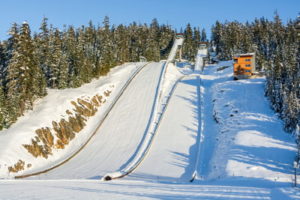 As with any other major skiing event, the majority of ski jumping’s biggest competitions actually come as part of an overall skiing competition rather than one specifically created for ski jumping. The best example of that is the Winter Olympics, with various hill types introduced to the competition over the years but with them fitting within a wider timetable of other events.
As with any other major skiing event, the majority of ski jumping’s biggest competitions actually come as part of an overall skiing competition rather than one specifically created for ski jumping. The best example of that is the Winter Olympics, with various hill types introduced to the competition over the years but with them fitting within a wider timetable of other events.
There are still a number of competitions work talking about though, with the main ones outside of the Olympics being as follows:
FIS Ski Jumping World Cup
Founded by Torbjørn Yggeseth ahead of the 1979-1980 season, the Ski Jumping World Cup is organised by the International Ski Federation. Women didn’t begin competing in it until the 2011-2012 season, which is common across most ski jumping disciplines.
There are numerous rounds held around the world during the year and it is broken down into singles, team and mixed team events.
Four Hills Tournament
Also known as German-Austrian Ski Jumping Week, this is made up of four World Cup events and sees Austria and Germany go head-to-head at Oberstdorf, Garmisch-Partenkirchen, Innsbruck and Bischofshofen.
Winners of all four events are said to have completed the Grand Slam and it has been taking place since 1953.
FIS Ski Jumping Grand Prix
This event is noteworthy because it’s a summer competition that takes place on artificial surfaces. It was created in 1994, with female skiers allowed to compete for the first time in 2012.
Seasons run from July to October and there are usually around ten competitions each year. It is essentially the summer variation of the Winter World Cup.
FIS Nordic World Ski Championships
This is an example of an event that involves numerous different skiing disciplines alongside ski jumping, rather than being a specialist event.
It has been taking place since 1925 for men and 1954 for women, though ski jumping didn’t start until 1962 and 2009 respectively.
